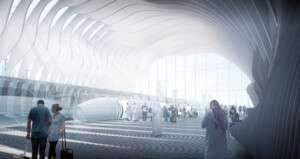the introduction:
As the 2034 World Cup approaches, Saudi Arabia is highlighting its enormous potential to host a global sporting event of new record standards. But ambition does not stop at the borders of sports fields; The Kingdom is preparing to revolutionize transportation and infrastructure by exploring the introduction of Hyperloop technology.

Explore how Saudi Arabia is preparing to break records at the 2034 World Cup by integrating hyperloop technology. Learn about the architectural and technological revolution that will connect cities, the design of the innovative sports stadium in NEOM, and discover how this cutting-edge technology can enhance the global event experience and infrastructure development.
Technological and architectural development:
Saudi Arabia is witnessing an architectural renaissance that reflects its strength and ability to innovate. By collaborating with technology pioneers such as Elon Musk, and drawing inspiration from successful hyperloop experiences, the Kingdom seeks to integrate this pioneering technology into its development plans. This is not only a development in transportation, but it redefines urban sprawl and enhances infrastructure in an unprecedented way.

Moving date:
To understand the value of this technological leap, it is important to look back, when trips between cities could take days or even weeks. 500 years ago, movement was limited to horses and carts, which imposed restrictions on trade, cultural contact, and urban expansion.
The importance of quick navigation:
In our fast-paced world, time is the most precious resource. Rapid movement between cities not only enhances the economy and trade, but also facilitates cultural and social access. Hyperloop, with speeds exceeding 1,000 km/h, could reduce the journey between two cities 500 km apart to less than 30 minutes – compared to 5 hours by car, 4 hours by train, and less than an hour by plane.
Hyperloop is not just a means of transportation; It is a symbol of innovation and future vision. As Saudi Arabia looks to the 2034 World Cup, an important question arises: How will this technology impact the visitor experience and long-term infrastructure? How will it contribute to shaping the future of mobility and urban development?

Technology as a hub for innovation and hosting:
Hyperloop technology, with its superior efficiency and speed, is an essential pillar that enables the Kingdom of Saudi Arabia to make a strong bid to host the 2034 World Cup. The ability to transport fans, players and officials smoothly and safely between major cities and sports sites will be a huge attraction. This innovation goes beyond just a transportation system; It reflects Saudi Arabia’s commitment to sustainability and efficiency, and reinforces its position as a leader in adopting advanced technology.
Connecting cities and the new explosion in industry:
Hyperloop not only provides fast transportation solutions, but also redefines connectivity between Saudi cities, helping to expand urban and economic growth. The design of future hyperloop stations is in line with Saudi Vision 2030; They are imagined as architectural works of art that embrace smart technologies and provide immersive experiences for users, making every journey a unique experience.
Architectural design of sports stadiums:
The expected World Cup stadiums in Saudi Arabia are not just spaces for sporting events, but rather artistic masterpieces that reflect the Kingdom’s heritage and future aspirations. They are envisioned as symbols of innovation, using sustainable materials and flexible designs that allow them to be transformed for multiple uses after the tournament. The development of these stadiums is a new chapter in the field of architecture in Saudi Arabia, as it combines sustainability, technology and culture.
Infrastructure development and sports stadium design in NEOM:
The phenomenal stadium that will form part of the NEOM project, which encompasses Saudi Arabia’s future vision, will encompass the height of infrastructure and architectural design. Artificial intelligence and sustainability will be emphasized through modern construction techniques that will maximize energy efficiency and reduce the environmental effect of the stadium. This stadium is far more than just the traditional sporting arena; it will also be a melting pot for social and cultural activities, which aptly reflects the spirit of innovation communicated by Saudi Arabia.
James Johnson, CEO of the Australian Football Association, on Saudi Arabia’s organization of the 2034 World Cup:

“Saudi Arabia has a bid to host the 2034 World Cup that is hard to beat,” says James Johnson, pointing to Saudi Arabia’s growing power in the international sporting arena. “Given the high level of Saudi preparations, Australia has decided to step back from applying for the competition and will instead offer its support to the Saudi bid.”


In a related context, innovative designs were revealed for a new sports stadium in downtown Jeddah, which is currently being built and stands out for its unique Hejazi architectural character that reflects Jeddah’s ancient heritage. This stadium, whose capacity has been announced in impressive detail, is expected to constitute a landmark that contributes to strengthening Saudi Arabia’s position as a strong host of major sporting tournaments.



 العربية
العربية